After the narcoleptic thrill-ride that was 2017’s The Mummy, I was glad to dive into the classics pool and watch the original 1932 version starring Boris Karloff. So glad in fact that I thought it would be pleasant to take a gander at some of the horror movies that Karloff starred in throughout the decades. In this little exercise, I am picking a random Karloff vehicle to look at during each week in October. This week is one film from the 1930s, next week the 1940s, then the 1950s, and finally the 1960s. I’d go further, but Boris didn’t, so I won’t.
First off, let me just iterate this so I can reiterate it later: I adore Boris Karloff. Such a terrific actor and a powerful presence. The movie might be great or awful, but Boris is good no matter what. And after sitting through Tom Cruise breaking land speed records by outrunning curses, I needed a healthy dose of the very first Mummy. I then needed more of Boris’ work to get that experience somewhat abated in my mind, so therefore I’m happily pressing forward with Mr. Karloff.
Also, my love of Karloff doesn’t mean that I harbor any ill will toward his filmic contemporary, Bela Lugosi. Depending on which way the wind blows, I sometimes enjoy Bela more than Boris and vice versa. They were both fabulous actors inside and outside of genre pictures. Karloff usually comes out ahead because unlike Lugosi, 1) Boris had a higher volume of better films with great talent behind the scenes, 2) Boris was never ever hurting for employment so he ended up with more work left behind, and 3) Boris lived over a decade longer than Bela, so it would have been hard for Bela to catch up.
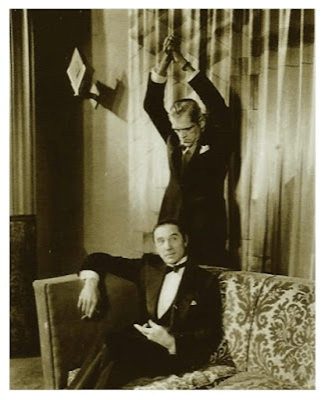
The 1930s made Karloff a star beyond measure. Yes, he had roles during the 1920s, but in the decade following, Boris could never have predicted how fast and far his star rose. The overwhelming success of Frankenstein in 1931 opened a huge door and Karloff’s career sprinted right through it. He had a supporting role in Howard Hawks’ Scarface and after that, a starring role as Fu Manchu. The Mummy followed and then came The Black Cat, The Bride of Frankenstein, and Son of Frankenstein to name but a few.
Karloff just wasn’t limited to horror roles during this time either. He not only starred in Charlie Chan at the Opera, one of the best Chan outings, but he also portrayed his own Asian detective in five Mr. Wong movies. Ultimately, Karloff made more than 30 movies after Frankenstein through to 1939. So that gives me quite a few films to choose from, but which one? Hmmmm…
With huge mountains such as the Frankenstein franchise and the Universal horror outings, some of the smaller hills get overlooked in the Karloff catalog. Not that every hill is a great hill. After all, the odds are impossible that every film you make during an entire decade is going to be astoundingly terrific. Well, unless you just happen to be 1980s Steve Guttenberg, of course. Putting aside The Guttenberg Exception as I’m now calling it, for just a moment, Karloff does have plenty of little underground hills that need some excavation for appreciation.

1933’s The Ghoul is one of those hills. (Okay, I’m done with the hills metaphor now. You’re welcome!) Following The Mummy, Karloff made The Ghoul for Gaumont British studios. The story is a simple one: Karloff plays an Egyptologist on his deathbed who believes that a precious jewel known as the Eternal Light is his ticket to immortality. After he dies, this jewel is to be placed in the hand of a statue of Anubis. If the statue comes to life, wrapping its hand around the gem, then Karloff has achieved his goal. But heaven help anyone who interferes with this supernatural resurrection process by taking that jewel…
Karloff always excelled in roles where he was wronged and pursues revenge. Yes, he could play incredible straight out evil as he did in The Mask of Fu Manchu or The Black Cat for example, but when given opportunities for incredible sympathy, Karloff is indeed a treat to watch. As a wrongfully disgraced scientist, a man haunted by his past or present, or as someone trapped in horrid circumstances beyond his control, Boris Karloff always shone. The Ghoul is no exception.
Despite Karloff’s deathbed entreaties, there are plenty of other cast members to keep an eye on in The Ghoul. The always reliable Sir Cedric Hardwicke plays Karloff’s estate manager, oozing plenty of “hey, I don’t like him”-ness throughout. Sir Ralph Richardson, a contemporary of legendary British Shakespearean actors Sir John Gielgud and Sir Laurence Olivier, makes his pre-knighted feature film debut as a seemingly ineffectual local parson.

Rounding out the cast are several good English actors whose names elude me for the moment. Although I did write down the name of Anthony Bushnell, our main protagonist. He’s all right I suppose but he conveys too much of the proper “stiff upper lip now, what a load of tommy rot, stuff and nonsense” Brititude in him for my liking. Yes, it was 1933 and yes, it was filmed in Britain, but I say, old chap! If Hitchcock could avoid some of this stereotyping in his films, why couldn’t everyone else?
Oh, before I move on, I almost forgot to mention a key member of the cast. (Well, not really. I had always planned to talk about him. I just did this for dramatic effect. No, you’re welcome again!) That member is the legendarily enjoyable Ernest Thesiger, who portrays Karloff’s butler, a very nervous, somewhat greedy Scottish character. Playing a devout Christian, he doesn’t agree with Karloff’s beliefs in the Egyptian gods, but he goes along his master’s wishes…somewhat.
Thesiger is always a delight on film. Of course, his most memorable role is the scene-stealing Dr. Pretorius in 1935’s The Bride of Frankenstein. Apparently, turnabout is fair play here in The Ghoul because in 1932’s The Old Dark House, Karloff played Thesiger’s butler so it is only right that he would return the favor for dear Boris.
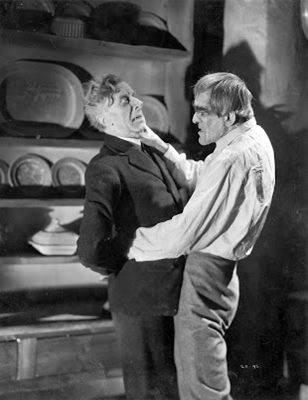
He hasn’t made Bride of Frankenstein yet!
There is an eerie atmosphere throughout the film with a wonderful use of shadows during a creepy night. I must also complement the quality of the print that was used for MGM’s DVD release. (There’s a U.K. Blu-ray out there that I’m told is even better.) The film was considered lost and incomplete for years. Then a heretofore forgotten film vault was discovered at Shepperton Studios and there a nigh pristine negative of The Ghoul was found! (Apparently a Shepperton tea trolley was knocked over and as the crumpets were gathered up, the trolley operator said, “’ello, ‘ello, ‘ello! What’s all this then? Oy! It’s a bleedin’ vault, guv!” Okay, that’s not strictly true as far as you know. Oh, England!)
Going back to Alfred Hitchcock, The Ghoul benefits from having Louis Levy doing the music. Levy was a composer and/or music director for nine classic Hitchcock movies of the 1930s. Quite an accomplishment! The music in The Ghoul is rather good, especially when comparing it to the regular musical fare in mystery/horror movies of the 1930s. The score is continuous, following the mood of the picture. Far too often, movies in this genre at that time used music sparingly. Levy didn’t follow the convention and I thank him for it.
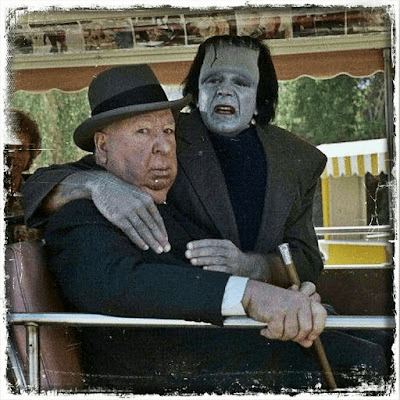
Another way the film doesn’t follow convention is that almost every character, save for Karloff, manages to get in a quip. The movie is not a comedy, so having those quick digs at another character was unexpected and quite pleasant. Oftentimes, the 1930s horror films, except for director James Whale’s output, shied away from comedic touches, making the product a rather serious business. The Ghoul by contrast has a lighter air about it. It might just be a British reaction when characters are placed in horror circumstances, but it works and isn’t overplayed for the sake of a laugh.
My one true beef with this movie: The Ghoul takes forever for Karloff’s revenge to get started. We are almost at the 50-minute mark before Karloff (SPOILER ALERT!!! DUCK AND COVER!!!) rises from the crypt and comes out looking for vengeance on whomever took the jewel. Now perhaps this is just my own problem because I’m impatient since I cannot get enough Karloff. But the whole movie is only 77 minutes long, so that doesn’t give a lot of time for spooky revenging action. Thankfully Hardwicke and Thesiger are there to help distract me from not seeing Boris as much as I wanted.
The risen Karloff is filled with perfect haunting menace! Seeking his jewel and attacking those that get in his way, Karloff proves why we came to see him. He even comes straight at the camera in what turns out to be a sudden close-up that made me move on my couch in a foolish attempt to get out of his way.

But The Ghoul isn’t done yet in playing with conventions. I find it quite remarkable that this early in the “dark old house/revenge of the dead” horror movie in the sound era, The Ghoul misleads the audience so effectively. (DUCK AND COVER AGAIN!!! SPOILERS ARE FALLING!!!) Karloff doesn’t resurrect supernaturally as it is revealed that he suffers from catalepsy and was buried alive in the first place.
This means that after Karloff woke up, he thought that he was brought back to life to seek revenge because the jewel was missing. So, the jewel turns out to be just a jewel and not a mystic resurrection tool. Which means that in the end, Christian butler Thesiger was correct about the Egyptian rites being nonsense. And yet in another switcheroo, it turns out that, Richardson’s parson, the film’s symbol of Christianity, isn’t a parson at all but is a thief trying to get the jewel! Dogs and cats, living together! Mass hysteria!
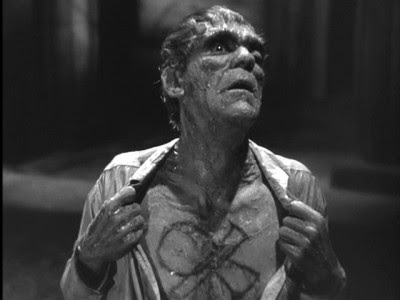
When all is said and done, The Ghoul is a nice way to spend an hour and a half to enjoy some fine British actors early on in their film careers. Richardson, Hardwicke, and Thesiger only add to the price of admission. The Ghoul is an entertaining story that clips along, it has plenty of atmosphere, and it displays Karloff amid his amazing 1930s rise.
I just hope that there isn’t going to be a Tom Cruise remake to spoil everything.
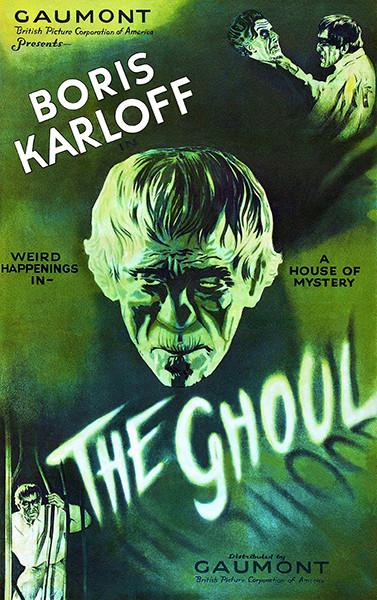
“There is an eerie atmosphere throughout the film with a wonderful use of shadows during a creepy night.”
Do you feel like modern horror has lost the ability to use shadow as a means to induce fear? I feel like the art of shadow work has been lost.
LikeLiked by 1 person
I couldn’t agree more. With films like these, you can almost feel the night air, smell the rooms in the house, hear the rustling leaves outside. There is much to be said for just allowing the atmosphere do the heavy lifting and oftentimes, that just doesn’t seem to fit into so much of modern horror.
LikeLiked by 1 person
Right. It’s interesting because I am a fan of most horror and I actually loved Malignant for this reason. I actually feel the overuse of fog was to pay homage to the classic films like Return of the Vampire and most hammer horror.
LikeLiked by 1 person
Hi Benjaminawink, what a fun review this is and what a cast! I am now adding The Ghoul to my Halloween viewing list and am looking forward to the rest of Boris month on your blog 🙂 Thanks for the heads up about this film.
LikeLiked by 1 person
My pleasure! There is so much fun to be discovered in the films that fell through the cracks!
LikeLiked by 2 people
I don’t think Cruise would be willing to have his face covered in makeup, so you’ve got that going for you, Sir. 🙂 x
LikeLiked by 1 person